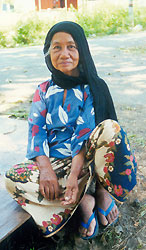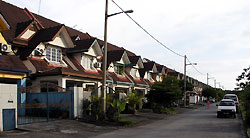| Period: 13 October -
21 December 2003. Country: Malaysia |
| (1) A Social History of Childbirth Practices in Peninsular Malaysia: Experiences of Rural Malay Women and Midwives |
| KATO Yuko (Division
of Southeast Asian Area Studies) |
| Key Words: Childbirth, Malay Village, Social Transformation, Medical Institution, Traditional Midwives |
 |
| A Malay traditional midwife. Even though hospital deliveries have become common, traditional midwives are still popular among Malay mothers for body massaging after child delivery. |
 |
| New housing estates have been built in urban areas since the 1980s. Most Malays who migrate from rural areas live in this type of housing estate (photograph by Colin Nicholas). |
(2) This dissertation aims to examine the transformation of rural society in Malaysia, focusing on the reproductive activities of Malay women, and the changing roles of “traditional midwives” in a Malay community over the last 50 years or so. While the increasing “hospitalization” of childbirth is a general trend for women of all ethnic groups in Malaysia, Malay women, especially those residing in rural areas, have experienced the most drastic changes in child delivery practices. Formerly, they preferred to deliver at their homes with the assistance of “traditional midwives,” while Chinese and Indian women who immigrated to Malaysia during British colonial era gave birth in hospitals in a comparatively earlier period. Only after the 1960s, when medical institutions such as midwife’s clinics were introduced into rural areas, did government midwives start to visit Malay mothers to assist in their childbirth or to advise them to deliver in the hospital.
The objective of my dissertation is to write a social history of a Malay village, focusing on historical changes in childbirth practices. In this endeavor I mainly rely on interviews with Malay women and “traditional midwives.” By examining the transformation of women’s reproduction or childbirth practices, I attempt to illustrate the process of state intervention in childbirth, family relationships and women’s activities, and how these have influenced people’s lives in a rural society.
(3) In the present field research, I surveyed 60 Malay villages located in the suburbs of Kajang in Peninsular Malaysia between October 13 and December 21, 2003. To narrow the range of Malay villages for the site of my dissertation research, I carried out comprehensive research on the histories, general socio-economic conditions, and residential patterns of these villages. I also conducted interviews with elders and women in some of the villages.
It is said that Malay villages in Peninsular Malaysia have experienced drastic social changes since the introduction of the "New Economic Policy” (the so-called “Bumiputra Policy”) in the 1970s. Malays who used to live by rice cultivation and rubber tapping in rural areas have received favorable treatment from the government in terms of employment and education. Also, many young Malays have migrated to urban areas since the 1970s. Through the present fieldwork I discovered that cash income had increased its significance tremendously in Malay rural households, while rice cultivation and rubber tapping had lost their economic importance, and that family size and composition had undergone changes. Looking at child delivery practices, “traditional midwives” no longer play a substantial role in the actual delivery of babies, but they still commonly practice body-massage for the mother after delivery.
|


 21st Century COE Program
-Aiming for COE of Integrated Area Studies-
21st Century COE Program
-Aiming for COE of Integrated Area Studies-